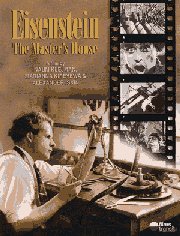
EISENSTEIN: THE MASTER'S HOUSE 2
 Eisenstein –asiantuntija ja Moskovan filmimuseon johtaja Naum Klejman on kirjoittanut dokumentin Sergei Eisensteinin elämästä ja työstä. The Master's House on kiehtova kuvaus suuresta elokuvaohjaajasta ja teoreetikosta. Tällä upealla dokumentilla Kakkosen 25. tunti aloittaa kevätkautensa. Lähetyspäivä vaihtuu vuoden alusta keskiviikosta sunnuntaiksi.
Eisenstein –asiantuntija ja Moskovan filmimuseon johtaja Naum Klejman on kirjoittanut dokumentin Sergei Eisensteinin elämästä ja työstä. The Master's House on kiehtova kuvaus suuresta elokuvaohjaajasta ja teoreetikosta. Tällä upealla dokumentilla Kakkosen 25. tunti aloittaa kevätkautensa. Lähetyspäivä vaihtuu vuoden alusta keskiviikosta sunnuntaiksi.Pitkän uransa aikana Eisenstein ohjasi, kirjoitti, tuotti, editoi ja jopa näytteli. Hänen tunnetuin työnsä on Battleship Potemkin. Sergei Eisenstein oli ensimmäinen elokuvantekijä, joka vakavasti käytti editointitekniikoita ja vaikkakin kaikki hänen elokuvansa olivat mykkäelokuvia, useita hänen tekniikoistaan ja jopa kohtauksia hänen elokuvistaan on käytetty muissa elokuvissa.
Dokumentti kuvaa Eisensteinin visuaalista ja henkistä maailmaa ja tutkii hänen inspiraationlähteitään. The Master's House sisältää kymmenen osaa, joita kutsutaan "taloiksi". Talot ovat: Father's house (Riika 1898-1915), Mother's house (Pietari 1915- 1920), Teacher's house (Moskova 1920-1924), Glasshouse (NL 1924-1929), Stepmother's house (Eurooppa-USA 1929-1930), Hacienda (Mexiko 1930-1932), The Tower (Moskova-Fergana 1932-1939), Walhalla (NL-Saksa 1939-42), Kreml (Alma Ata- Moskova 1942-46), Krypta (1947-1948). Jokainen talo edustaa tiettyä ajankohtaa ja tiettyä vaihetta Eisensteinin elämässä.
Dokumentissa Naum Klejman ja hänen kaksi ohjaajaansa, Marianna Kirejewa ja Alexander Iskin, yhdistävät mielikuvia vapaasti assosioiden, jotta oppisimme tuntemaan Eisensteinin henkistä maailmaa, hänen koulutustaan, taidettaan ja luovan elämänsä paineita. Dokumentti sisältää katkelmia Eisensteinin ja hänen ihailemiensa ohjaajien elokuvista sekä historiallisia, dokumentaarisia kohtauksia ja valokuvia. Dokumentti imitoi siten Eisensteinin ajattelutapaa. Hänen luovuutensa perustui yllättävien ja epätavallisten yhteyksien luomiseen eri kulttuurien ja ajanjaksojen välille.
The Master's House on ainutlaatuinen dokumentti loistavasta teoreetikosta, jollaista filmiteollisuus ei ole nähnyt hänen jälkeensä.
- Ohjaaja: Marianna Kirejewa ja Alexander Iskin
- Tuotanto: Profit, Venäjä, 1998
In English In English In English
EISENSTEIN: THE MASTER'S HOUSE
 Riga, around the turn of the century. A six-month-old baby is looking at us. In a rapid succession of shots, he changes into a two-year-old, a six-year-old, an eleven-year-old boy, an adolescent and finally, into a young man: Rorik Seryozha - Sergei Eisenstein. His father, a councilor of state, is fashionable architect in Riga. His mother comes from a wealthy St. Petersburg merchant family. Young Sergey is expected also become an engineer and architect.
Riga, around the turn of the century. A six-month-old baby is looking at us. In a rapid succession of shots, he changes into a two-year-old, a six-year-old, an eleven-year-old boy, an adolescent and finally, into a young man: Rorik Seryozha - Sergei Eisenstein. His father, a councilor of state, is fashionable architect in Riga. His mother comes from a wealthy St. Petersburg merchant family. Young Sergey is expected also become an engineer and architect.Early this century, Russia still gives the appearance of being a quiet, peaceful country. With the 1917 Revolution this deceptive idyll explodes. So does family life at the Eisensteins'. His parents divorce. Eisenstein, still in the uniform of a student of the Civil Engineering Institute, goes to theaters, reads Nietzsche and Schopenhauer, and dreams of the arts.
For Sergey the revolution is the road to personal freedom, abandoning architecture, he turns towards the theater.
In 1920, Eisenstein goes to Moscow to become a student of Meyerhold's. For his first theatrical mise-en-scčne at the Proletkult Theatre, The Wise Man, Eisenstein shoots a short film. Two years later, in 1925 Eisenstein shoots Battleship Potemkin, which makes him world famous at once. By 1929, Eisenstein has made two more silent films, The General Line (1926-29) and October (1927).
Working on The General Line brings him also the first clashes with Sowiet censorship. Eisenstein leaves for study trip: Berlin, Paris, London. In Marseille, word reaches his that a contract with Paramount has been prepared for him. In Hollywood Eisenstein remains a mystery to the American producers. Eisenstein goes to Mexico, to shoot a film for Upton Sinclair. But Que viva Mexico fails - too much rain, too little confidence - the film is not completed. He goes back to Moscow. There the same fate awaits his next film, Bezhin Meadows. After two thirds of the film has been shot, the project in abandoned. In 1938 Eisenstein makes Alexander Nevsky. In 1944, Eisenstein shoots Ivan the Terrible I - not a bloodthirsty tsar but a victorious Russian hero, followed by Ivan the Terrible II, but now a tsar who is fighting his enemy by means of bloody terror. An outcry from the Kremlin. The film in banned as historically incorrect. During shooting of Ivan the Terrible III, Eisensterin gets a heart attack. Ivan the Terrible III was never to be completed.
- Directors Marianna Kirejewa and Alexander Iskin
- Production: Profit, Russia, 1998

Päivitys: 27.12.1998.U.E.